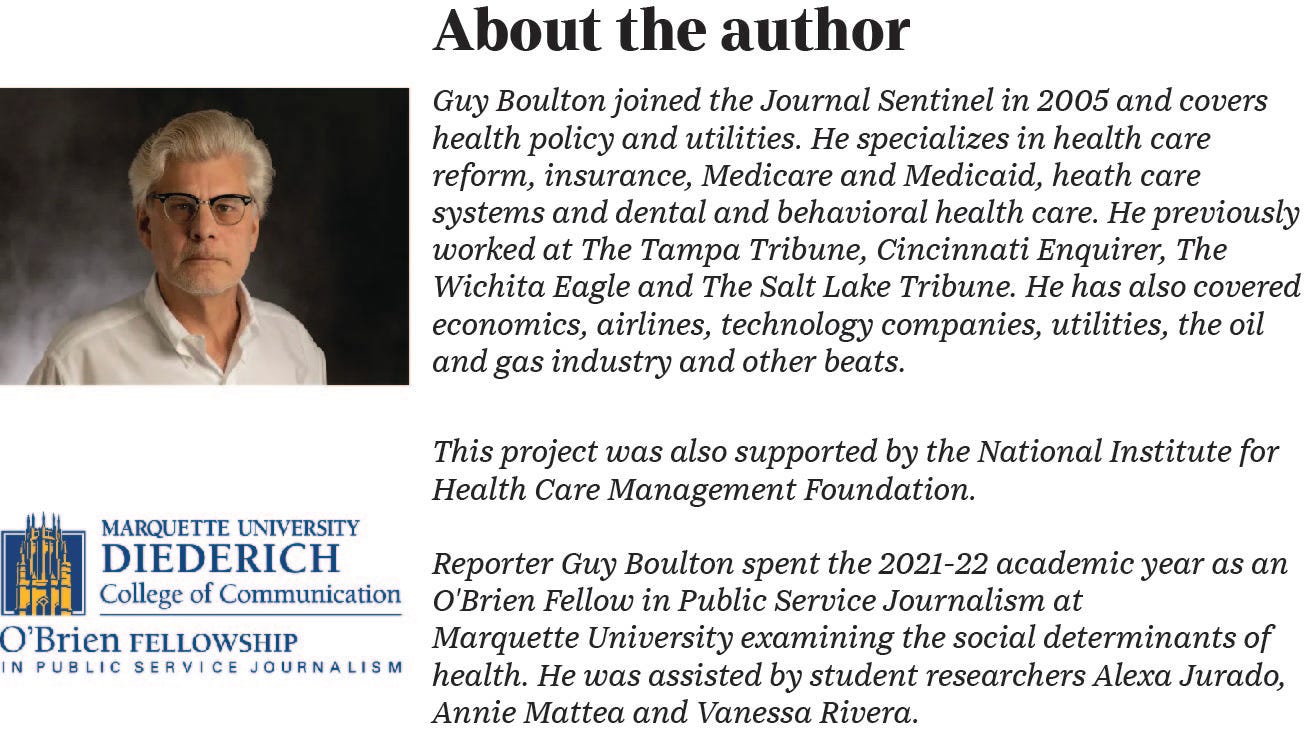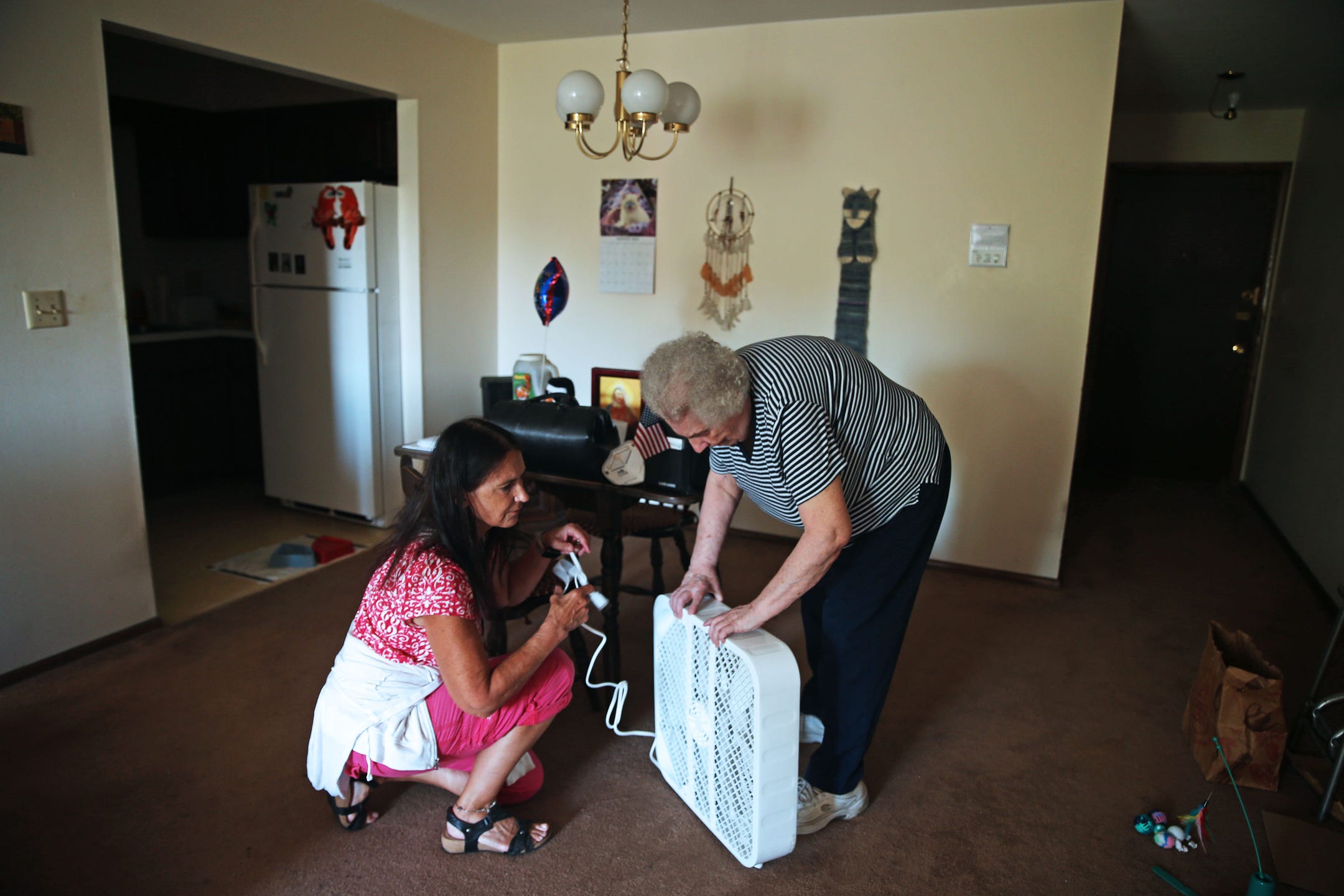
Jenny Ovide, left, a nurse at Ascension All-Saints Family Health Center, delivers a new fan to Ellen Tetting during a home visit. Ovide has been meeting with Tetting at her home for 15 years. Angela Peterson/Milwaukee Journal Sentinel
Jenny Ovide, left, a nurse at Ascension All-Saints Family Health Center, delivers a new fan to Ellen Tetting during a home visit. Ovide has been meeting with Tetting at her home for 15 years. Angela Peterson/Milwaukee Journal Sentinel
What Amy Kind observed during her residency as a physician at Massachusetts General Hospital in Boston often frustrated and angered her.
She could admit a poor person to the hospital again and again, each time potentially costing tens of thousands of dollars.
“Yet changing someone’s ability to have safe housing — even getting an air conditioner for someone with breathing problems — was not something I could do,” said Kind, now a professor at the University of Wisconsin School of Medicine and Public Health.
One of the realities of our health system — the world’s most expensive, accounting for almost one-fifth of the U.S. economy – is that access to hospitals and doctors alone will not improve the overall health of people who face the challenge of being poor.
Housing, food, transportation, income and education — even something as simple as an air conditioner — can be more important to health than access to even the best physicians and hospitals.
Homeless people can visit an emergency department weekly and remain in poor health. Severe diabetics who run out of food when their nutrition assistance benefits are exhausted will struggle to control their blood sugar. Children with asthma living in a home ridden with mold, or infested with mice and cockroaches, will have trouble breathing no matter what care they receive.
The United States will spend hundreds and even thousands of dollars when poor people visit an emergency department — and much more when they are hospitalized. But the country does not ensure that they have adequate housing or food.
“It is much, much easier as a clinician to get someone a $40,000 pill than it is to get someone a housing improvement that costs $1,000,” Kind said, “even though that housing improvement may impact health much more than the $40,000 pill.”
Across the country, hundreds of initiatives are beginning to focus on the social determinants, or drivers, of health — the conditions in which people are born, live and work. Those conditions include housing, food, education, well-paying jobs, neighborhoods and the support of friends and family.
Health systems such as Dignity Health and Kaiser Permanente, both based in California, and Bon Secours Mercy Health, based in Maryland, now invest in affordable housing. Boston Medical Center, Cincinnati Children’s Hospital, Philadelphia Children’s Hospital and others have set up legal clinics to help their patients navigate hurdles such as tenants’ rights and immigration rules.
Commercial health insurers and state Medicaid programs are doing the same. Massachusetts, Minnesota, Oregon and North Carolina are among the states taking steps toward integrating medical care with social services, providing rental assistance, and meals to prevent costly hospitalizations.
In Wisconsin, Ascension Wisconsin launched a program that provides healthy meals for patients as they take a class on managing diabetes. Common Ground Healthcare Cooperative and the Dohmen Company Foundation have partnered on a program that supplies 10 meals a week to those in need. Sixteenth Street Community Health Centers has lawyers available at its clinics several times a month. Chorus Community Health Plans, formerly Children’s Community Health Plan, United Healthcare and Anthem Blue Cross Blue Shield provide housing for some people at risk of high medical bills.

But it's not nearly enough.
Kind is among the increasing number of physicians who have called for a better balance between money spent on health care — particularly costly high-tech care — and money spent on the social and economic conditions that influence health.
“Many times, we know what is needed to improve health care,” she said. “We know that we need healthy food, a healthy environment, high-quality education, the opportunities for social cohesion.”
Health systems and insurers still are learning what works best. Many of the initiatives are pilot programs or limited in scope, and their cost is often small compared to the billions of dollars in reserves that large health systems have in investment portfolios.

Other countries flip spending
The United States spends more on health care — at least 50% more — than any other developed country. At the same time, the country spends far less on social services, such as housing subsidies, job training, unemployment benefits, preschool and income support, than those countries.
Yet the combined total — what the United States spends on health care and social services as a percentage of its economy — is roughly the same as other industrialized countries.
By one estimate, for every dollar the United States spends on health care, the country spends about 56 cents on social services — with much of that spending skewed to people over 65.
The ratio of total spending is almost the reverse in other industrialized countries.
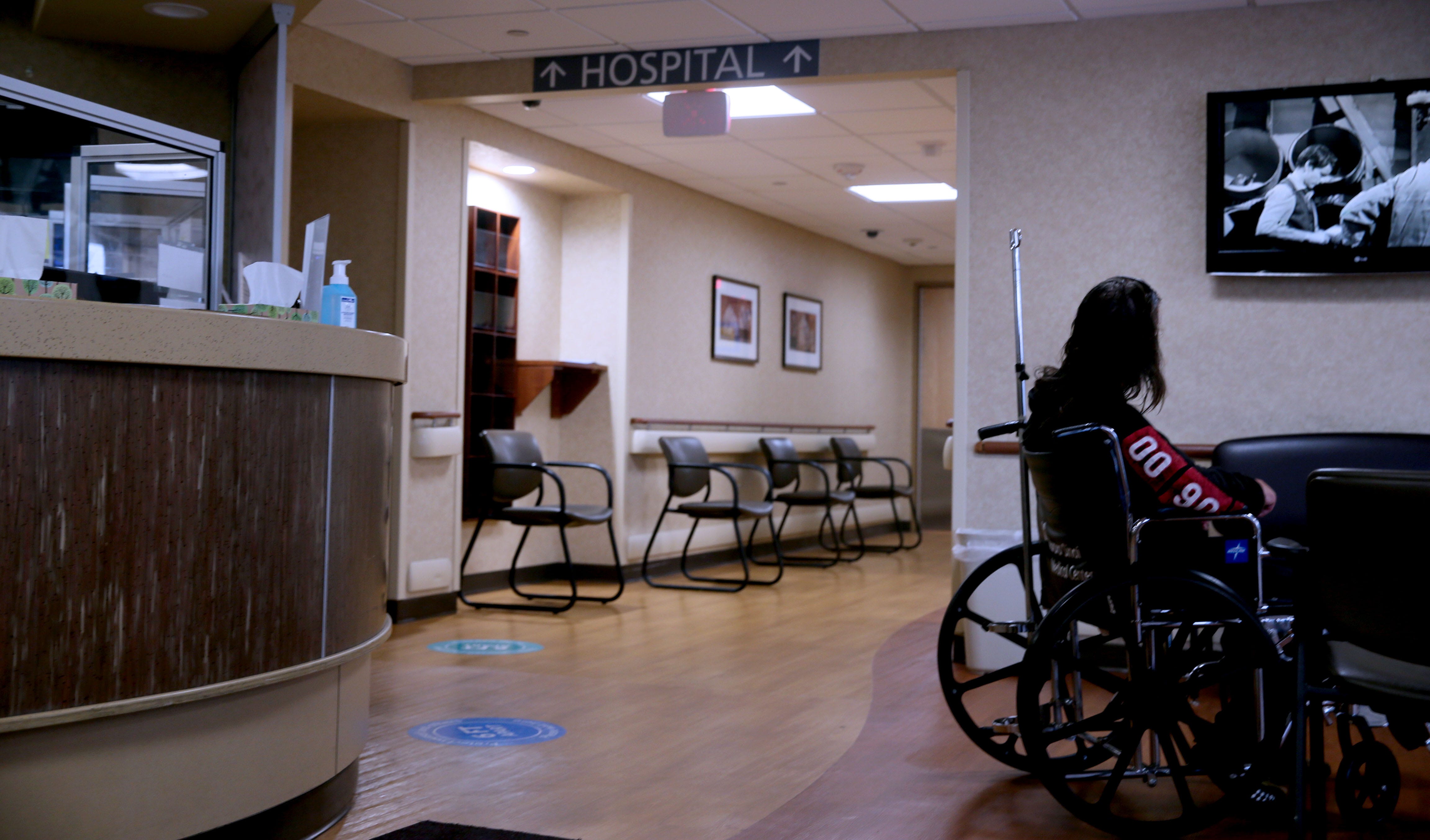
For every dollar those countries spend on health care, they spend about $1.70 on social services.
(The comparison is somewhat distorted by the high prices for health care in the United States compared with other countries.)
At the same time, the United States lags other industrialized countries in many health measures, such as life expectancy and infant mortality.
“The health care system right now treats people on an encounter basis,” said Leonard Egede, a physician and professor of medicine at the Medical College of Wisconsin.
People see a physician or other clinician at a hospital or clinic, are treated and return home.
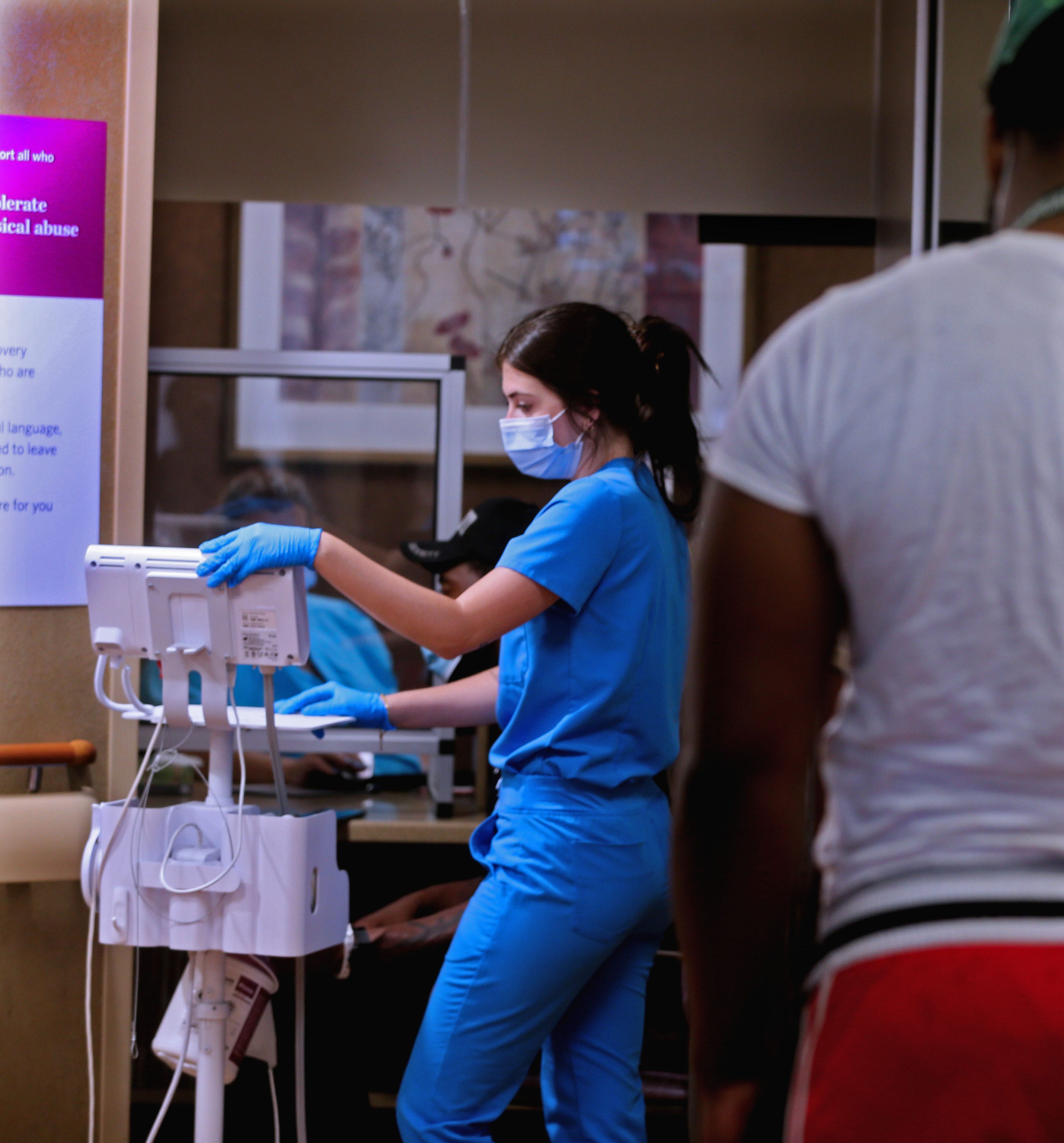
“What many of us are pushing for is to recognize that people live in communities,” Egede said.
For Egede and others, social policy and economic policy are health policy.
A survey done earlier this year by the Physicians Foundation found that eight in 10 physicians believe the United States cannot improve health outcomes or reduce health care costs without addressing the social and economic conditions that affect health.
More than nine in 10 of the 1,502 physicians who responded to the survey also said at least some of their patients’ health outcomes were affected by at least one social driver of health. The most common was financial instability.
More than eight in 10 said the challenges and frustrations in addressing those problems contribute to physician burnout.
“We need good quality medical care, and we need good access to it,” said Geoffrey Swain, a physician and emeritus professor at the UW School of Medicine and Public Health. “We also need to be focusing on these other things.”

Health care only plays one role
Clinical care — receiving health care in a medical setting — accounts for only about 20% of a person’s overall health, according to the County Health Rankings and Roadmaps compiled by the UW Population Health Institute, with support from the Robert Wood Johnson Foundation.
Social and economic factors, such as education, employment, income, community safety, family and social support, account for about 40%; health behaviors, such as rates of alcohol and drug use, diet and exercise, and tobacco use, account for about 30%; and physical environment, such as air and water quality, account for about 10%.
Researchers debate the exact percentage that health care contributes to the overall health of the population — and when someone faces a serious illness, health care clearly is all-important. But they agree that the other influences or drivers of health matter just as much or more.
Those influences partly explain the disparities in health between people who have enough money to have relatively comfortable lives with at least a modicum of financial security, and those who do not.
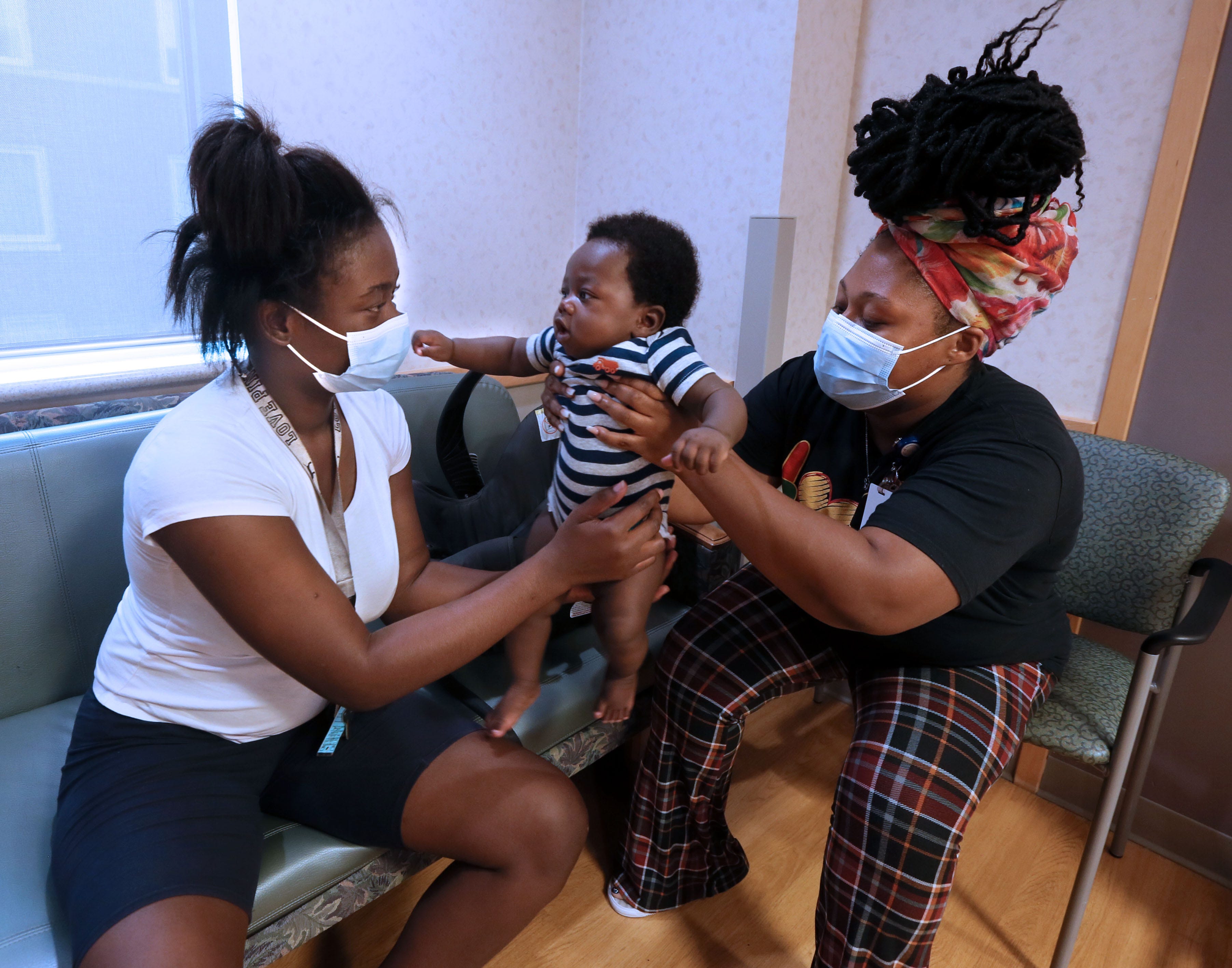
The disparities are pronounced in Milwaukee and Wisconsin, particularly for people who are Black or Latino.
A child who lives in one of the poorest neighborhoods in Milwaukee, for example, is 20 times more likely to visit a hospital emergency department for a severe asthma attack than a child who lives in Whitefish Bay.
Wisconsin ranked 35th out of 38 states in health outcomes for Blacks in a report from the Commonwealth Fund released in November. (The number of people who are Black or Latino was too small in some states for an accurate estimate.) The state ranked 30th out of 42 states for Latinos. It ranked substantially better, 20th out of 51, for whites.
The gap can be seen in life expectancies.
Someone who lives in a census tract — the optimum size has about 4,000 people — in Mequon will live roughly 20 years longer on average than someone who lives in two predominantly Black and poor census tracts in Milwaukee, according to a survey done by the U.S. Census Bureau.
More broadly, someone who is Black and lives in Milwaukee County is 3.1 times more likely to die before the age of 75 than someone who lives in Ozaukee County, according to the County Health Rankings and Roadmaps.
The gap cannot be attributed directly to violence. The top five leading causes of death — cancer, heart disease, accidents, chronic respiratory disease, and diabetes — are the same in Milwaukee and Ozaukee counties.
One difference: The median household income in Ozaukee County was $90,400 in 2019 compared with $30,900 for Black households and $40,900 for Latino households in Milwaukee County.

Pandemic reinforced differences
Income is the single best indicator of life expectancy in the United States.
Part of that can be tied to behavioral differences between the wealthiest and poorest, especially smoking, obesity and exercise, according to a landmark 2016 study in the Journal of American Medicine, or JAMA.
Life expectancy increases continuously with income, and the connection affects all races, and urban and rural areas alike.
Determining how income affects health is difficult. Different influences — housing, education, transportation, social support — are interrelated. But the connection is clear at each and every percentile of the income distribution.
That’s especially troubling because income inequality has increased in recent decades.

The initial wave of the pandemic drew national attention to these disparities. People who lived in the poorest neighborhoods, particularly Blacks, were dying at much higher rates.
“We had seen communities that were not thriving before the pandemic hit — that weren’t doing well in terms in economic security, in terms of education, in terms of health outcomes,” said Christine Muganda, who oversees data and analytics for the County Health Rankings and Roadmaps.
“And those are the same communities that we saw suffering most and first when the pandemic hit.”
One reason: A disproportionate percentage of people in communities of color worked in low-wage jobs in the service sector and did not have the option of working safely from home.
“COVID just underscored everything that we knew was already a faultline in our communities — (it) made those things bigger and brought them to light in a really salient way,” Muganda said.

What we need 'is different now'
Today, health systems, health insurers, nonprofit organizations and foundations are beginning to put more emphasis on the so-called “upstream” conditions that affect health.
That is a new mindset for health care systems, which were designed to diagnose and treat disease and injury, said Veronica Gunn, a pediatrician, and CEO of Genesis Health Consulting in Milwaukee.
“But what we need as a society is different now,” Gunn said.
Gunn, who was an executive at Children’s Wisconsin and chief medical officer for the Tennessee Department of Health, is on the board of the Health Initiative — a campaign to persuade health insurers, foundations, and federal and state agencies to increase investments in the social, economic, environmental, and behavioral influences on health.
Gunn and others talk about spending more money on health as opposed to paying for health care.
That's beginning to happen.
From Jan. 1, 2017, to Nov. 30, 2019, for instance, 57 health systems, with a total of 917 hospitals among them, announced commitments to invest more than $2.5 billion in 78 programs to address housing, employment, education, food security and other drivers of health, according to an article in Health Affairs.
The pledges included $1.6 billion for initiatives on affordable housing.
That’s just a snapshot.
More than 65 health systems — consisting of more than 1,000 hospitals and $75 billion in purchasing power — have pledged to allocate a small portion of their investment portfolios to affordable housing, food security, child development and small business development as part of the Healthcare Anchor Network.
The organization was founded in 2016 to encourage health systems — generally among the largest employers in their communities — to use their purchasing, hiring and investment portfolios to address economic and racial inequities.
Its members have pledged to set aside more than $900 million over five years, said Bich Ha Pham, senior director of communications and policy. Its members also have pledged to increase hiring and buying from local businesses in poor neighborhoods owned by minorities and women.
Members with operations in Wisconsin include Advocate Aurora Health, Ascension Health, Froedtert Health and SSM Health.

In the Milwaukee area, Advocate Aurora, Froedtert Health and Ascension Wisconsin have joined with Children’s Wisconsin, the Medical College of Wisconsin, Marquette University and University of Wisconsin-Milwaukee in pledging to increase their hiring and purchasing in eight of Milwaukee’s poorest neighborhoods.
“Health systems realized they have to do something about this,” said Len Nichols, a health economist and emeritus professor of health policy at George Mason University.

'The bones of two-year projects'
Health systems in the Milwaukee area are taking initial steps to address the underlying conditions that affect health. Ascension Wisconsin is donating $500,000 to PRISM Economic Development Corp. to support its UpStart Kitchen, a restaurant incubator in Sherman Park that provides entrepreneurs with access to a commercial kitchen and business resources. Advocate Aurora has made a series of similar grants to community organizations.
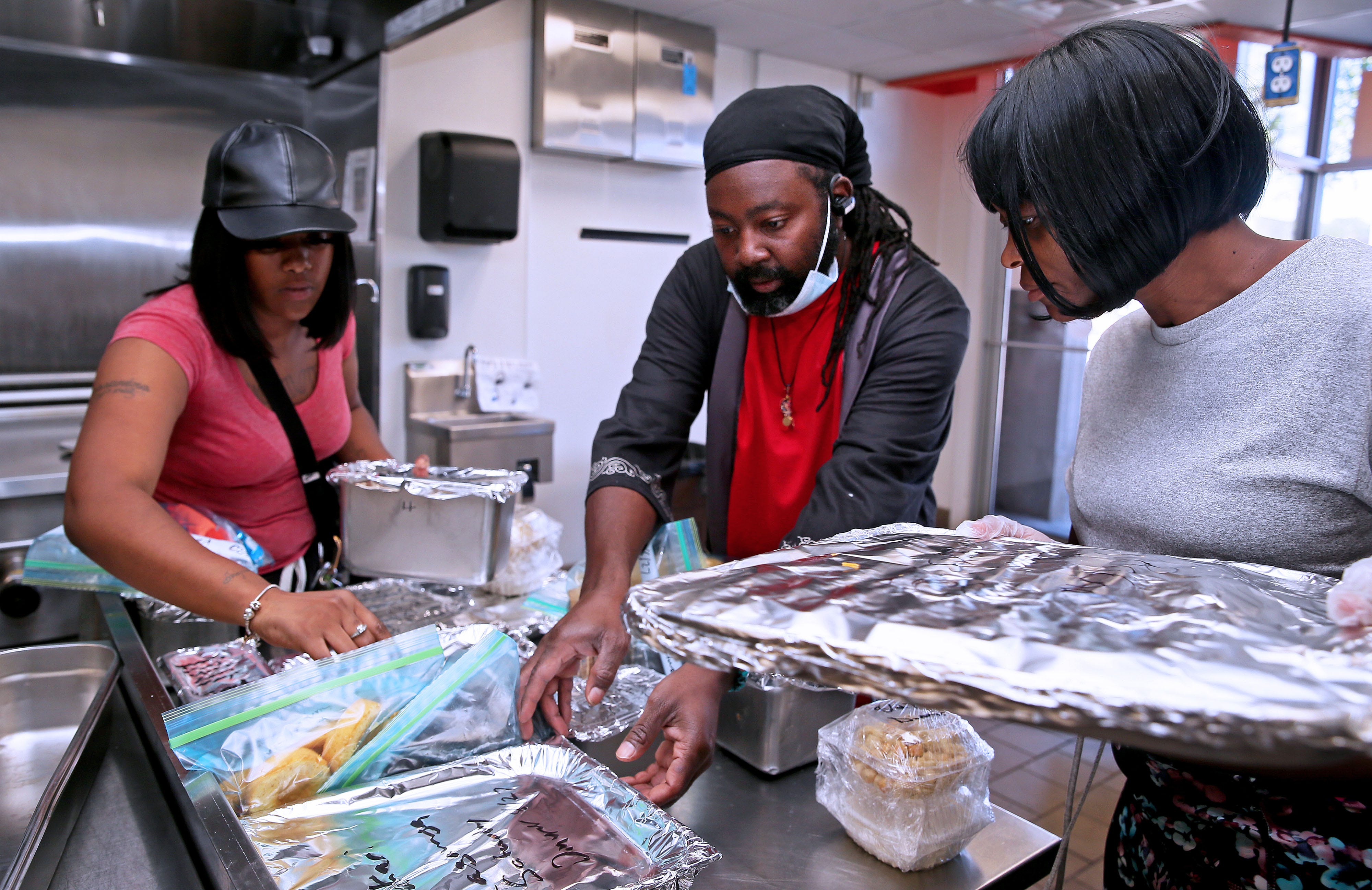
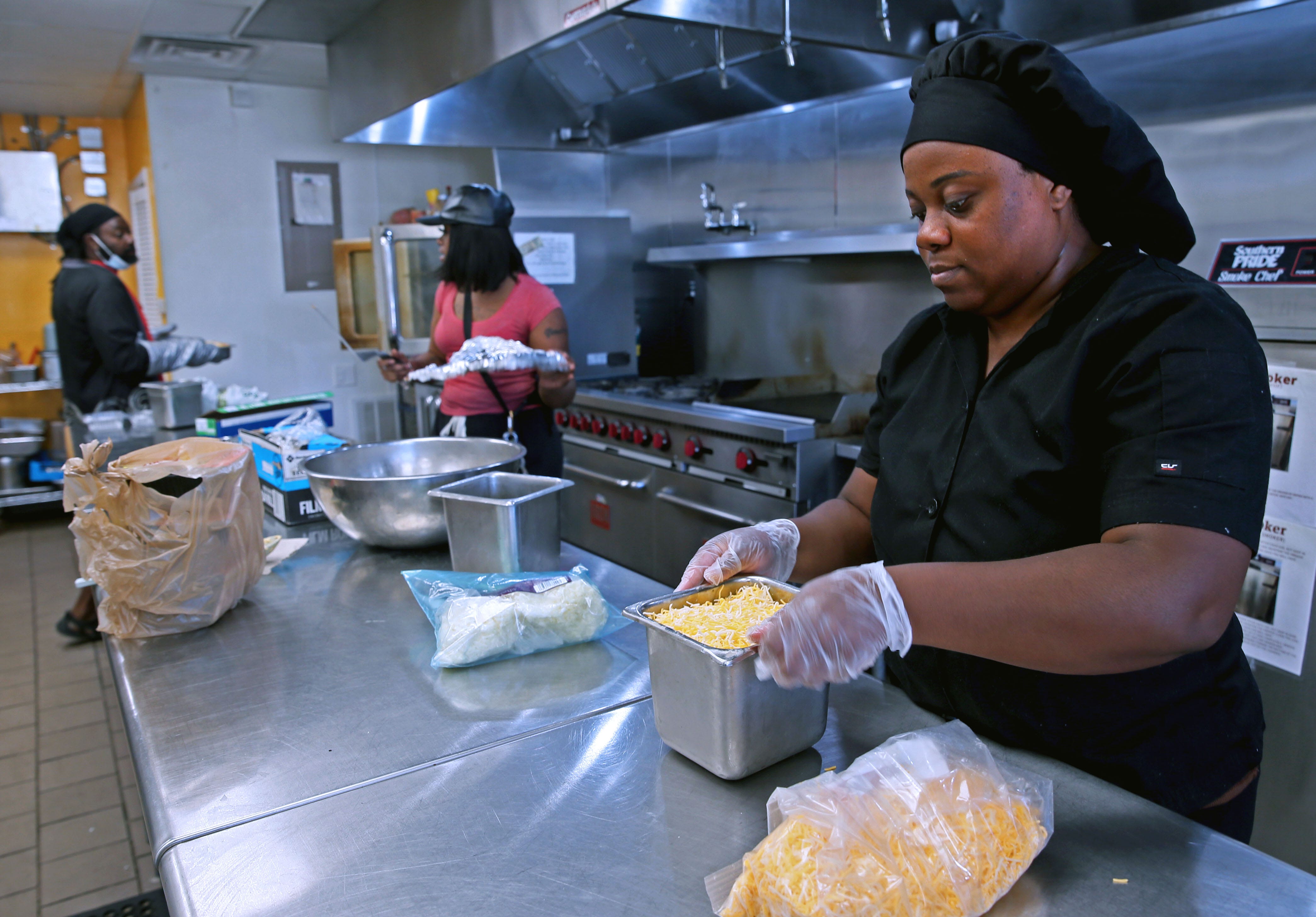
The question is whether the efforts can be sustained and given time to succeed.
Zeno Franco, an associate professor at the Medical College of Wisconsin, said projects often will be funded for the short-term — and then the money dries up. A colleague once said to him that “Milwaukee is littered with the bones of two-year projects."
At the same time, communities cannot expect health systems to fund every initiative.
“We can’t do this work alone,” said Reggie Newson, chief community impact and advocacy officer for Ascension Wisconsin.
Further, the work to integrate health care with social services will take years, probably decades.
“It’s going to take some resiliency and perseverance. Absolutely,” Newsom said. “These problems didn’t happen overnight, and it’s going to take time to address them.”
Still, some basic steps are being taken.
Health systems, community health centers and health insurers have long employed social workers and case managers, who generally help patients with complex medical conditions. Now, many health systems, including those in Wisconsin, are screening patients for unstable housing or food insecurity the same way they ask patients questions about their health and medical history.
Impact — the nonprofit, confidential 211 helpline and online resource directory for nine counties in southeastern Wisconsin — is putting in place software that will enable physicians and other clinicians to make referrals directly to the organization, the same way that they make referrals for tests and to specialists.
Impact maintains a database of thousands of resources, from food pantries to government agencies to support groups.
Without question, some initiatives will fail. What works in one community may not work in another. Scaling programs can bring additional challenges.
“There are a lot of different places where the slip between the lip and the cup can happen,” said Nichols, the emeritus professor at George Mason University.
Further, not every effort will save money.
“In general, you should not assume moving $1 from health care into social services is going to lead to a $1 offset in health care spending,” Nichols said.
If given time and shaped in the right way, though, some initiatives have the potential to lower costs, improve people’s lives and boost health equity. By one estimate, eliminating just racial and ethnic disparities would reduce medical care costs by $230 billion over four years — and the indirect costs of poor health and mortality by more than $1 trillion.
“We know more about what we can do than five years ago, and even two years ago," Nichols said, "so there is just way more potential for actual action.”
There now is even a bipartisan Congressional caucus on the social determinants of health.
“That is a huge deal, because it signals — correctly — that this is not a partisan issue,” he said.
There are obvious obstacles. Potential benefits and savings are in the future, and resources are limited. And there is what has been called the “wrong-pocket” problem — when one organization or sector pays for an initiative but the benefits accrue to another. For example, when a health system invests in affordable housing, the savings, in the form of lower health care costs, may be realized by a health insurer.
Nevertheless, health care organizations and and the communities in which they operate often have more resources than they realize, Nichols said. The key is to break down silos and get them to work together.
“That’s what’s beautiful about this work,” Nichols said. “It is simultaneously good for health care organizations, good for people, good for communities and good for the society that is interested in improving equity.”
Alexa Jurado contributed to this report while attending Marquette University and working as a research assistant to O'Brien Fellow Guy Boulton.
